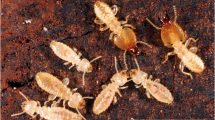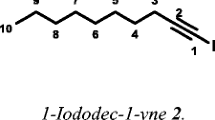Abstract
The composition of chemical weaponry of termite soldiers show interspecific and intraspecific variation. However, spatial effects on the qualitative and quantitative compositions of these substances in Neotropical termites are poorly known. Hexane extracts of heads and the defensive secretion of soldiers of Constrictotermes cyphergaster from four localities in Northeast Brazil were analyzed by gas chromatography and mass spectrometry. Chemical analysis allowed the detection of 54 compounds from the head extract and from the direct extraction of the defensive secretion of soldiers, and the percentage of common substances and the presence of exclusive substances varied depending on the spatial distance between colonies. The profile of the chemical armament of soldiers consists basically of terpenoids: monoterpenes (45.53%-71.97 - for head extract and 57.41% - 78.56 for secretion) and sesquiterpenes (19.69% - 35.78% for head extract and 18.41% - 33.31%for secretion). In general, the main component of the chemical arsenal, regardless of the methodology used for extraction, was α-pinene (27.98–50.44%). Two chemotypes were identified based on chemical differences between populations of ecoregions with distinct spatial-environmental and climate characteristics: (1) α-pinene <33%; (2) α-pinene >33% for both extracts (head and secretion). The results reveal a similar pattern of chemical differentiation for soldiers in both extracts (head and secretion), with increasing differences as a function of distance between the analyzed colonies.


Similar content being viewed by others
References
Adams RP (2007) Identification of essential oil components by gas chromatography/mass spectrometry. Allured Publishing Corp., Carol Stream, IL, USA, 808p
Azevedo NR, Ferri PH, Seraphin JC, Brandão D (2006) Chemical composition and intraspecific variability of the volatile constituents from the defensive secretion of Constrictotermes cyphergaster (Isoptera, Termitidae, Nasutitermitinae). Sociobiology 47:1–12
Bagnères AG, Clément JLA, Blum MS, Severson RF, Joulie C, Lange C (1990) Cuticular hydrocarbons and defensive compounds of Reticulitermes flavipes (Kollar) and R. santonensis (Feytaud): polymorphism and chemotaxonomy. J Chem Ecol. 1990. https://doi.org/10.1007/BF00982094
Baker R, Organ AJ, Prout K, Jones R (1984) Isolation of a novel triacetoxysecotrinervitane from the termite Constrictotermes cyphergaster (termitidae, sub-family Nasutitermitinae). Tetrahedron Letters 25:579–580. https://doi.org/10.1016/s0040-4039(00)99943-x
Benton TG, Vickery JA, Wilson JD (2003) Farmland biodiversity: is habitat heterogeneity the key? Trends in Ecology and Evolution 18:182–188. https://doi.org/10.1016/S0169-5347(03)00011-9
Bezerra-Gusmão MA, Kogiso KA, Honorato TO, Melo TX, Barbosa JRC, Bandeira AG (2009) Polycalic nest system and levels of aggression of Constrictotermes cyphergaster (Isoptera, Termitidae, Nasutitermitinae) in the semi-arid region of Brazil. Sociobiology 53:101–111
Bezerra-Gusmão MA, Barbosa JRC, Barbosa MRV, Bandeira AG, Sampaio EVSB (2010) Are nests of Constrictotermes cyphergaster (Isoptera, Termitidae) important in the C cycle in the driest area of semiarid caatinga in Northeast Brazil? Appl Soil Ecol 47:1–5. https://doi.org/10.1016/j.apsoil.2010.11.003
Bezerra-Gusmão MA, Marinho RA, Kogiso KA, Barbosa MRV, Bandeira AG (2013) Nest dynamics of Constrictotermes cyphergaster (Termitidae, Nasutitermitinae) and its association with the supporting vegetation in a semiarid area, northeast. Brazil Journal of Arid Environments 91:1–6. https://doi.org/10.1016/j.jaridenv.2012.11.003
Cancello EM, Silva RR, Vasconcellos A, Reis YT, Oliveira LM (2014) Latitudinal variation in termite species richness and abundance along the Brazilian Atlantic Forest hotspot. Biotropica. 46:441–450. https://doi.org/10.1111/btp.12120
Cristaldo PF, Jandák V, Kutalová K, Rodrigues VB, Brothánek M, Jiříček O, Desouza O, Šobotník J (2015) The nature of alarm communication in Constrictotermes cyphergaster (Blattodea: Termitoidea: Termitidae): the integration of chemical and vibroacoustic signals. Biology open 4:1649–1659. https://doi.org/10.1242/bio.014084
Da Camara CAG, De Moraes MM., De Melo JPR, Da Silva, MMC (2017) Chemical Composition and Acaricidal Activity of Essential Oils from Croton rhamnifolioides Pax and Hoffm. in Different Regions of a Caatinga Biome in Northeastern Brazil. Journal of Essential Oil Bearing Plants. https://doi.org/10.1080/0972060x.2017.1416677
Dool VDH, Kratz PDJA (1963) Generalization of the retention index system including linear temperature programmed gas-liquid partition chromatography. J Chromatogr 11:463–471
Eggleton P, Bignell DE, Hauser S, Dibog L, Norgrove L, Madong B (2002) Termite diversity across an anthropogenic gradient in the humid forest zone of West Africa. Agric Ecosyst Environ 90:189–202. https://doi.org/10.1016/S0167-8809(01)00206-7
Everaerts C, Pasteels JM, Roisin Y, Bonnard O, Braekman JC, Daloze D (1988) Morphological and Chemichal criteria in the taxonomy of Nasutitermes from Papua New Guinea (Isoptera:Termitidae). Sociobiology 14:193–206
Fuller CA (2007) Fungistatic activity of freshly killed termite, Nasutitermes acajutlae, soldiers in the Caribbean. J Insect Sci 7:1–8. https://doi.org/10.1673/031.007.1401
Geron C, Guenther A, Sharkey T, Arnts RR (2000) Temporal variability in basal isoprene emission factor. Tree Physiol 20:799–805. https://doi.org/10.1093/treephys/20.12.799
Goh SH, Chuah CH, Tho YP, Prestwich GD (1984) Extreme intraspecific chemical variability in soldier defense secretions of allopatric and sympatric colonies of Longipeditermes longipes. J Chem Ecol 10:929–944. https://doi.org/10.1007/BF00987974
Gush TJ, Bentley BL, Prestwich GD, Thorne BL (1985) Chemical variation in defensive secretions of four species of Nasutitermes. Biochem Syst Ecol 13: 329–336. https://doi.org/10.1016/0305-1978(85)90044-4
Hazell SP, Groutides C, Neve BP, Blackburn TM, Bale JS (2010) A comparison of low temperature tolerance traits between closely related aphids from the tropics, temperate zone, and Arctic. J Insect Physiol 56:115–122. https://doi.org/10.1016/j.jinsphys.2009.08.020
Hortal J, Roura-Pascual N, Sanders NJ, Rahbek C (2010) Understanding (insect) species distributions across spatial scales. Ecography. 33:51–53. https://doi.org/10.1111/j.1600-0587.2009.06428.x
Jaworski T, Hilszczański J (2013) The effect of temperature and humidity changes on insects development their impact on forest ecosystems in the expected climate change. For Res Pap 74:345–355. https://doi.org/10.2478/frp-2013-0033
Krasulová J, Hanus R, Kutalová K, Šobotník J, Sillam-Dussès D, Tichý M, Valterová I (2012) Chemistry and anatomy of the frontal gland in soldiers of the sand termite Psammotermes hybostoma. J Chem Ecol 38:557–565. https://doi.org/10.1007/s10886-012-0123-9
Mathews AGA (1977) Studies on termites from the Mato Grosso state, Brazil. Academia Brasileira de Ciências, Rio de Janeiro
McCoy ED (1990) The distribution of insects along elevational gradients. Oikos 58:313–322
Mélo ACS, Bandeira AGA (2004) Qualitative and quantitative survey of termites (Isoptera) in an open shrubby caatinga in Northeast Brazil. Sociobiology 44:707–716
Mello AP, Azevedo NR, Barbosa-Silva AM, Bezerra-Gusmão MA (2016) Chemical composition and variability of the defensive secretion in Nasutitermes corniger (Motschulsky, 1885) in urban area in the Brazilian semiarid region. Entomotropica 31:82–90
Moura FMS, Vasconcellos A, Araújo VFP, Bandeira AG (2006) Seasonality in foraging behavior of Constrictotermes cyphergaster (Termitidae, Nasutitermitinae) in the caatinga of northeastern Brazil. Insect Soc 53:472–479. https://doi.org/10.1007/s00040-005-0899-0
Moura FMS, Vasconcellos A, Silva NB, Bandeira AG (2011) Caste development systems of the Neotropical térmite Constrictotermes cyphergaster (Isoptera, Termitidae). Insect Soc 58:169–175. https://doi.org/10.1007/s00040-010-0132-z
MMA - Ministério do Meio Ambiente (2010) Monitoramento dos biomas brasileiros: Bioma Caatinga. MMA, Brasília
Nascimento SS, Alves JJA (2008) Ecoclimatologia do Cariri Paraibano. Revista Geográfica Acadêmica 2(3):28–41
Oksanen J, Blanchet FG, Kindt R, Legendre P, Minchin PR, O’Hara RB, Wagner H (2015) Vegan: Community Ecology Package. Retrieved from http://cran.r-project.org/ package=vegan
Panizzi AR, PARRA JRP (2009) Bioecologia e nutrição de insetos: base para o manejo integrado de pragas. EMBRAPA/CNPQ, Brasília
Perdereau E, Dedeine F, Christides JP, Bagnères AG (2010) Variations in worker Cuticular hydrocarbons and soldier Isoprenoid defensive secretions within and among introduced and native populations of the subterranean termite, Reticulitermes flavipes J Chem Ecol https://doi.org/10.1007/s10886-010-9860-9, 36
Piskorski R, Hanus R, Vašíčková S, Cvačka J, Šobotník J, Svatoš A, Valterová I (2007) Nitroalkenes and Sesquiterpene hydrocarbons from the frontal gland of three Prorhinotermes termite species. J Chem Ecol 33:1787–1794. https://doi.org/10.1007/s10886-007-9341-y
Prestwich G (1984) Defense mechanisms of termites. Annual Review Entomology 29:201–232. https://doi.org/10.1146/annurev.en.29.010184.001221
Prestwich GD (1977) Chemical composition of the soldier secretions of the termite Trinervitermes gratiosus. Insect Biochem 7:91–94. https://doi.org/10.1016/0020-1790(77)90062-2
Prestwich GD (1979) Interspecific variation in the defence secretions of Nasutitermes soldiers. Biochemical and Systematic Ecology 7:211–221. https://doi.org/10.1016/0305-1978(79)90052-8
Prestwich GD, Collins MS (1981) Chemotaxonomy of Subulitermes and Nasutitermes termite soldier defense secretions. Evidence against the hypothesis of diphyletic evolution of the Nasutitermitinae Biochemical and Systematic Ecology 9:83–88. https://doi.org/10.1016/0305-1978(81)90064-8
Prestwich GD, Jones RW, Collins MS (1981) Terpene biosynthesis by nasute termite soldiers (Isoptera: Nasutitermitinae). Insect Biochem 11:331–336. https://doi.org/10.1016/0020-1790(81)90011-1
Quintana A, Reinhard J, Faure R, Uva P, Bagnères AG, Massiot G, Clément JLA (2003) Interspecific variation in terpenoid composition of defensive secretions of European Reticulitermes termites. J Chem Ecol 29:639–652. https://doi.org/10.1023/a:1022868603108
R Core Team (2019) R: a language and environment for statistical computing. R Foundation for Statistical Computing, Vienna
Roisin Y (1988) Morphology, development and evolutionary significance of the working stages in the caste system of Prorhinotermes (Insecta, Isoptera). Zoomorphology. 107:339–347. https://doi.org/10.1007/BF00312217
Rosengaus RB, Lefebvre ML, Traniello JFA (2000) Inhibition of fungal spore germination by Nasutitermes: evidence for a possible antiseptic role of soldier defensive secretions. J Chem Ecol 26:21–39. https://doi.org/10.1023/A:1005481209579
Sampaio EVSB (1995) Overview of the Brazilian Caatinga. In: Bullock SH, Mooney HA, Medina E (eds) Seasonally Dry Tropical Forests. Cambridge University Press, Cambridge, U. K., pp 35–58
Savopoulou-Soultani M, Papadopoulos NT, Milonas P, Moyal P (2012) Abiotic factors and insect abundance. Psyche: A Journal of Entomology. https://doi.org/10.1155/2012/167420
Silvestri F (1901) Nota preliminare sui Termitidi sud-americani. Bollettino dei Musei di Zoologia ed Anatomia Comparata della Reale Università di Torino 16 (389):1–8
Šobotník J, Hanus R, Jirošová A (2010) Chemical warfare in termites. J Insect Physiol 56:1012–1021. https://doi.org/10.1016/j.jinsphys.2010.02.012
Tarver MR, Schmelz EA, Rocca JR, Scharf ME (2009) Effects of soldier-derived Terpenes on soldier caste differentiation in the termite Reticulitermes flavipes. J Chem Ecol 35:256–264. https://doi.org/10.1007/s10886-009-9594-8
Torres RNS, Lopes JAD, Neto MM, Citó AMGL (2008) The volatile constituents of propolis from Piaui. Química nova 31:479–485. https://doi.org/10.1590/S0100-40422008000300003
Valterova I, Vrkocˇ J, Norin T (1993) The enantiomeric composition of monoterpene hydrocarbons in the defensive secretions of Nasutitermes termites (Isoptera): inter- and intraspecific variations. Chemoecology. 4:120–123. https://doi.org/10.1007/BF01241682
Vanbergen AJ, Watt AD, Mitchell R, Truscott AM, Palmer SCF, Ivits E, Eggleton P, Jones TH, Sousa JP (2007) Scale-specific correlations between habitat heterogeneity and soil fauna diversity along a landscape structure gradient. Oecologia. 153:713–725. https://doi.org/10.1007/s00442-007-0766-3
Vasconcellos A, Araujo VFP, Moura FMS, Bandeira A (2007) Biomass and population structure of Constrictotermes cyphergaster Silvestri (Isoptera: Termitidae) in the dry forest of Caatinga, northeastern Brazil. Neotropical Entomology 36:693–698. https://doi.org/10.1590/S1519-566X2007000500009
Velloso AL, Sampaio EVSB, Pareyn, FGC (2002) Ecorregiões propostas para o bioma caatinga. Associação Plantas do Nordeste; Instituto de Conservação Ambiental, The Nature Conservancy do Brasil, Recife
Vrkoc J, Krecek J, Hrdy I (1978) Monoterpenic alarm pheromones in two Nasutitermes species. Acta Entomol Bohemoslov 75:1–8
Funding
The authors thank Coordenação de Aperfeiçoamento de Pessoal de Nível Superior - CAPES for a research grant; Fundação de Amparo à Ciência e Tecnologia do Estado de Pernambuco - FACEPE for a research grant (grant numbers: APQ-1008-1.06/15; APQ-0476-1.06/14; APQ-0860-1.06/16) and CNPq for a research grant (proc. 304210/2017–0 and PQ-2-302860/2016–9).
Author information
Authors and Affiliations
Contributions
APM and AV formulated the research. APM, AV, MMM and CAGC defined the sample design and methodology to be used. APM performed field collections. APM and MMM performed the chemical analyses. APM, MMM, CAGC and AV participated int eh process of writing, reviewing and approving the manuscript for submission.
Corresponding author
Supplementary Information
ESM 1
(DOCX 167 kb)
Rights and permissions
About this article
Cite this article
De Mello, A.P., De Moraes, M.M., Da Câmara, C.A.G. et al. Effect of Spatial Variation on Defensive Substances of Constrictotermes Cyphergaster Soldiers (Blattaria, Isoptera). J Chem Ecol 47, 544–551 (2021). https://doi.org/10.1007/s10886-021-01271-0
Received:
Revised:
Accepted:
Published:
Issue Date:
DOI: https://doi.org/10.1007/s10886-021-01271-0




